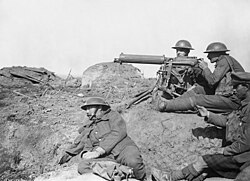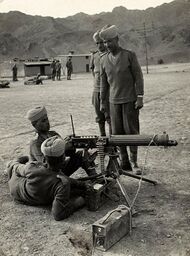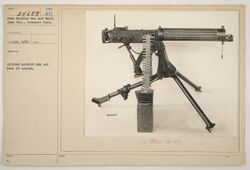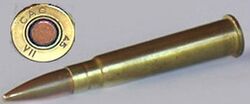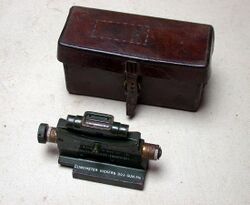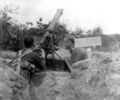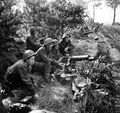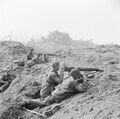Vickers machine gun
Topic: Engineering
 From HandWiki - Reading time: 23 min
From HandWiki - Reading time: 23 min
| Vickers machine gun | |
|---|---|
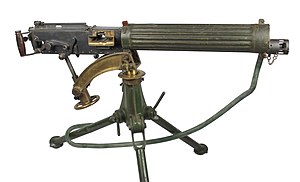 A Vickers Machine Gun mounted on a tripod. This example is at York Castle Museum. | |
| Type | Heavy machine gun |
| Place of origin | United Kingdom |
| Service history | |
| In service | 1912–1968 |
| Used by | See Users |
| Production history | |
| Designed | 1912 |
| Manufacturer | Vickers |
| Unit cost | £175 in 1914,[1] £80 in 1918,[2] ~£50 in 1926[3] |
| Specifications | |
| Mass | 33–51 lb (15–23 kg) all-up |
| Length | 3 ft 8 in (1.12 m) |
| Barrel length | 28 in (720 mm) |
| Crew | Three man crew |
| Cartridge | .303 British .30-06 Springfield 11mm Vickers others |
| Action | Recoil with gas boost |
| Rate of fire | 450 to 500 round/min |
| Muzzle velocity | 2,440 ft/s (744 m/s) (.303 Mk. VII ball) 2,525 ft/s (770 m/s) (.303 Mk. VIIIz ball) |
| Effective firing range | 2,187 yd (2,000 m) |
| Maximum firing range | 4,500 yd (4,115 m) indirect fire (.303 Mk. VIIIz ball) |
| Feed system | 250-round canvas belt |
The Vickers machine gun or Vickers gun is a water-cooled .303 British (7.7 mm) machine gun produced by Vickers Limited, originally for the British Army. The gun was operated by a three-man crew but typically required more men to move and operate it: one fired, one fed the ammunition, the others helped to carry the weapon, its ammunition, and spare parts.[4] It was in service from before the First World War until the 1960s, with air-cooled versions of it on many Allied World War I fighter aircraft.
The weapon had a reputation for great solidity and reliability. Ian V. Hogg, in Weapons & War Machines, describes an action that took place in August 1916, during which the British 100th Company of the Machine Gun Corps fired their ten Vickers guns to deliver sustained fire for twelve hours. Using 100 barrels, they fired a million rounds without breakdowns. "It was this absolute foolproof reliability which endeared the Vickers to every British soldier who ever fired one. It never broke down; it just kept on firing and came back for more."[5]
History
The Vickers machine gun was based on the successful Maxim gun of the late 19th century. After purchasing the Maxim company outright in 1896, Vickers took the design of the Maxim gun and improved it, inverting the mechanism as well as reducing its weight by lightening and simplifying the action and using high strength alloys for certain components. A muzzle booster was also added.
The British Army formally adopted the Vickers gun as its standard machine gun under the name Gun, Machine, Mark I, Vickers, .303-inch on 26 November 1912.[6] There were shortages when the First World War began, and the British Expeditionary Force was still equipped with Maxims when sent to France in 1914.[7] Vickers was threatened with prosecution for war profiteering, due to the exorbitant price demanded for each gun.[8] As a result, the price was much reduced. As the war progressed, and numbers increased, it became the British Army's primary machine gun, and was used on all fronts during the conflict.
| 1914 (Aug.-Dec.) | 1915 | 1916 | 1917 | 1918 | Total |
|---|---|---|---|---|---|
| 266 | 2405 | 7429 | 21782 | 39473 | 71355 |
When the Lewis Gun was adopted as a light machine gun and issued to infantry units, the Vickers guns were redefined as heavy machine guns, withdrawn from infantry units, and grouped in the hands of the new Machine Gun Corps (when heavier 0.5 in/12.7 mm calibre machine guns appeared, the tripod-mounted, rifle-calibre machine guns such as the Vickers were further re-classified as "medium machine guns"). After the First World War, the Machine Gun Corps (MGC) was disbanded and the Vickers returned to infantry units.
Before the Second World War, there were plans to replace the Vickers gun as part of a widescale change from rimmed to rimless rounds; one of the contenders was the 7.92mm Besa machine gun (British-built Czech ZB-53 design), which eventually became the British Army's standard tank-mounted machine gun. However, the Vickers remained in service with the British Army until 30 March 1968. Its last operational use was in the Radfan during the Aden Emergency.[8] Its successor in UK service is the British L7 variant of the FN MAG general purpose machine gun.
Use in aircraft

In 1913, a Vickers machine gun was mounted on the experimental Vickers E.F.B.1 biplane, which was probably the world's first purpose-built combat aeroplane. However, by the time the production version, the Vickers F.B.5, had entered service the following year, the armament had been changed to a Lewis gun.[10]
During World War I, the Vickers gun became a standard weapon on British and French military aircraft, especially after 1916, initially in a single gun configuration (Nieuport 17, SPAD VII, Sopwith Triplane), increased to a twin-gun standard in later war fighters (Nieuport 28, SPAD XIII, Sopwith Camel), with exceptions such as the S.E.5, which had a single synchronized Vickers and a Lewis gun mounted above the upper wing. Although heavier than the Lewis, its closed bolt firing cycle made it much easier to synchronise to allow it to fire through aircraft propellers. The belt feed was enclosed right up to the gun's feed-way to inhibit the effect of wind. Steel disintegrating-link ammunition belts were perfected in the UK by William de Courcy Prideaux in mid-war and became standard for aircraft guns thereafter.[11] From 1917 to 1919, French Manufacture d'armes de Châtellerault produced under license .303 Vickers machine guns (240 were delivered before the Armistice) but most of the French aircraft Vickers machine guns were British-made.[12]
By 1917 it had been determined that standard rifle calibre cartridges were less satisfactory for shooting down observation balloons than larger calibres carrying incendiary or tracer bullets; the Vickers machine gun was chambered in the 11mm Vickers round, known as the Vickers aircraft machine gun and sometimes the "Balloon Buster", and was adopted by the Allies as a standard anti-balloon armament, used by both the British and French in this role until the end of the war.[13][14]
The famous Sopwith Camel and the SPAD XIII types used twin synchronized Vickers, as did most British and French fighters between 1918 and the mid-1930s. In the air, the weighty water-cooling system was rendered redundant by low temperatures at high altitude and the constant stream of air passing over the gun (and lack of any need for sustained fire such as employed by ground troops); but because the weapon relied on boosted barrel recoil, the (empty) water-holding barrel jacket or casing was retained. Several sets of louvered slots were cut into the barrel jacket to aid air cooling, a better solution than that which had initially been attempted with the 1915-vintage lMG 08 German aircraft ordnance.
In 1918 the slotted modified original barrel jacket was replaced with a slimmer jacket on the Mk. II version,[15] and in 1927 a muzzle flash suppressor was added on the Mk. II*.[16]
As the machine gun armament of US and UK fighter aircraft moved from the fuselage to the wings in the years before World War II, the Vickers was generally replaced by the faster-firing and more reliable[17] Browning Model 1919 using metal-linked cartridges. The Gloster Gladiator was the last RAF fighter to be armed with the Vickers, later replaced by Brownings.[18] The Fairey Swordfish was fitted with the weapon until production ended in August 1944.[19]
Several British bombers and attack aircraft of the Second World War mounted the Vickers K machine gun or VGO, a completely different design, resembling the Lewis gun in external appearance.
Vickers machine guns, designated as models E (pilot's) and F (observer's, fed from a pan magazine) were also used among others in Poland, where 777 of them were converted to 7.92×57mm Mauser cartridge in 1933–1937.[20]
Variants
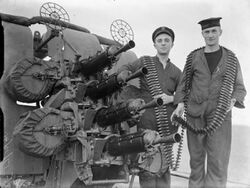
The larger calibre (half-inch) version of the Vickers was used on armoured fighting vehicles and naval vessels. The Gun, Machine, Vickers, .5-inch, Mk. II was used in tanks, the earlier Mark I having been the development model. This entered service in 1933 and was obsolete in 1944. Firing either single shot or automatic it had a pistol type trigger grip rather than the spades of the 0.303 in (7.7 mm) weapon.
The Gun, Machine, Vickers, .5-inch, Mk. III was used as an anti-aircraft gun on British ships.[21] This variation was typically four guns mounted on a 360° rotating and (+80° to −10°) elevating housing. The belts were rolled into a spiral and placed in hoppers beside each gun. The heavy plain bullet weighed 1.3 oz (37 g) and was good for 1,500 yd (1,400 m) range. Maximum rate of fire for the Mark III was about 700 rpm from a 200-round belt carried in a drum. They were fitted from the 1920s onwards, but in practical terms, proved of little use. During the Second World War, the naval 0.5 in (12.7 mm) version was also mounted on power-operated turrets in smaller watercraft, such as Motor Gun Boats and Motor Torpedo Boats.
The Mark IV and V guns were improvements on the Mark II. Intended for British light tanks, some were used during the war on mounts on trucks by the Long Range Desert Group in the North Africa Campaign.[21]
The Vickers machine gun was produced, between the wars, as the vz.09 machine gun.[citation needed]
Foreign service
The Vickers was widely sold commercially and saw service with many nations and their own particular ammunition. It was also modified for each country and served as a base for many other weapons.[which?] For example:
- 6.5×52mm Mannlicher–Carcano[22]
- 6.5×50mmSR Arisaka[23]
- 6.5×53mmR[24]
- 7×57mm Mauser[25]
- .280 British[26]
- 7.5×55mm Swiss[23]
- 7.62×51mm NATO[27]
- .30-06 Springfield[28]
- 7.62×54mmR[29]
- 7.65×53mm Argentine[30]
- 7.7×58mm Arisaka (licensed as the "fixed type" Type 89 machine gun)[31]
- 8mm Lebel (2,000 ordered by France in 1914[32] but only 52 delivered)[12]
Service after World War II
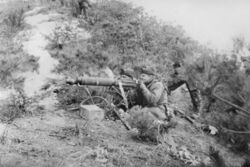
The Union of South Africa retained a large inventory of surplus Vickers machine guns after World War II. Many of these were donated to the National Liberation Front of Angola (FNLA) and National Union for the Total Independence of Angola (UNITA) during the Angolan Civil War.[27] Angolan militants were usually trained in their use by South African advisers.[27] Small quantities re-chambered for 7.62 mm NATO ammunition remained in active service with the South African Defence Force until the mid-1980s, when they were all relegated to reserve storage.[27] Six were withdrawn from storage and reused by a South African liaison team operating with UNITA during the Battle of Cuito Cuanavale, after which the weapons were finally retired.[34]
In the mid-1960s, the Vickers machine gun remained in service in countries such as India,[35] Israel[36] and Egypt.[37] It saw action with the Ceylon Army in the 1971 JVP insurrection.
Colt–Vickers M1915
By the early 1900s, the U.S. military had a mixed collection of automatic machine guns in use that included M1895 "potato diggers", 287 M1904 Maxims, 670 M1909 Benét–Mercié guns, and 353 Lewis machine guns. In 1913, the U.S. began to search for a superior automatic weapon. One of the weapons considered was the British Vickers machine gun.
Captain John S. Butler, Office of the Chief of Ordnance[29]
Field tests were conducted of the Vickers in 1914, and the gun was unanimously approved by the board for the army under the designation "Vickers Machine Gun Model of 1915, Caliber .30, Water-Cooled". One hundred twenty-five guns were ordered from Colt's Manufacturing Company in 1915, with an additional 4,000 ordered the next year, all chambered for .30-06. Design complexities, design modifications, and focus on producing previously ordered weapons meant that when the U.S. entered World War I in April 1917, Colt had not manufactured a single M1915.[29]
Production began in late 1917 with shipments to the Western Front in mid-1918. The first twelve divisions to reach France were given French Hotchkiss M1914 machine guns, and the next ten had M1915s. The next twelve divisions were to have Browning M1917 machine guns, but there was a shortage of parts. By August 1918, thirteen U.S. divisions were armed with the Colt–Vickers machine gun, and many aircraft were armed with the weapons as well (2,888 guns were converted). 7,653 guns were issued during the war out of 12,125 produced in total. War damage losses reduced the number of M1915s in the U.S. Army inventory from 9200+ to about 8,000 total.[29]
After World War I, the Colt–Vickers machine guns were kept in reserve until World War II. Several hundred were sent to the Dutch East Indies and the Philippines, and were all eventually lost to enemy action.[38] In 1940 and 1941, a total of 7,071 M1915 guns were purchased by the United Kingdom[39] to re-equip their forces after the Dunkirk evacuation, which depleted the weapon from the U.S. inventory before their entry into the war. Because the M1915 Colt–Vickers was not chambered for the standard British .303, it was painted with a red band to differentiate it and restricted it to Home Guard use.[29]
Specifications
The weight of the gun itself varied based on the gear attached, but was generally 25 to 30 pounds (11 to 14 kg) with a 40-to-50-pound (18 to 23 kg) tripod. The ammunition boxes for the 250-round ammunition belts weighed 22 pounds (10.0 kg) each. In addition, it required about 7.5 imperial pints (4.3 L) of water in its evaporative cooling system to prevent overheating. The heat of the barrel boiled the water in the jacket surrounding it. The resulting steam was taken off by a flexible tube to a condenser container—this had the dual benefits of avoiding giving away the gun's location, and also enabling re-use of the water, which was very important in arid environments.
In British service, the Vickers gun fired the standard .303 inch cartridges used in the Lee–Enfield rifle, which generally had to be hand-loaded into the cloth ammunition belts. There was also a 0.5 in calibre version used as an anti-aircraft weapon and various other calibres produced for foreign buyers.
The gun was 3 feet 8 inches (112 cm) long and its cyclic rate of fire was between 450 and 600 rounds per minute. In practice, it was expected that 10,000 rounds would be fired per hour, and that the barrel would be changed every hour—a two-minute job for a trained team. The Vickers gun could sustain fire for long durations of time exceeding the recommended 10,000 rounds an hour due to the water-cooled barrel and hourly barrel swaps. One account states that a Vickers fired just under 5 million rounds in a week as a test in 1963 at Strensall Barracks and was still operable.[40] The muzzle velocity was 2,440 ft/s (744 m/s) ±40 ft/s (12 m/s) with Mark VII(z) ammunition and 2,525 ft/s (770 m/s) with Mark VIIIz ammunition. The Mark VIIIz cartridge, which had a boat-tailed spitzer 'streamlined' bullet, could be used against targets at a range of approximately 4,500 yd (4,115 m). The bullet jackets were generally made of an alloy of cupro-nickel, and gilding metal. Ammunition for the Vickers used colour-coded annuli. Tracer ammunition was marked with a red annulus; armouring-piercing ammunition with a green annulus, and incendiary ammunition with a blue annulus. Explosive ammunition was marked with an orange annulus before the Second World War and was changed to black.
Use
The gun and its tripod were carried separately and both were heavy. The Vickers Mk I was 30 lb (13.6 kg) without the water and tripod, and weighed 40 lb (18.1 kg) with the water. The original design did not anticipate it being carried up jungle-covered mountains on men's backs, but such was the weapon's popularity that men were generally content to pack it to all manner of difficult locations. The tripod would be set up to make a firm base, often dug into the ground a little and perhaps with the feet weighted down with sandbags.
The water jacket would be filled with about 4 litres (1.1 US gal) of water from a small hole at the rear end, sealed by a cap. The evaporative cooling system, though heavy, was very effective and enabled the gun to keep firing far longer than its air-cooled rival weapons. If water was unavailable, soldiers were known to resort to using their urine.[41] It was sometimes claimed that crews would fire off a few rounds simply to heat their gun's cooling water to make tea, despite the resulting brew tasting of machine-oil.[42] In extremely cold weather, the cooling water could freeze and damage the gun. This problem was addressed using an insulating water jacket cover, introduced in 1918 but still in use during the Korean War. Some crews added vehicle antifreeze, others drained the water jacket, or simply fired a few rounds periodically to keep the water from freezing.[43]
The loader sat to the gunner's right, and fed in belts of cloth, into which the rounds had been placed. The weapon would draw in the belt from right to left, pull the next round out of the belt and into the chamber, fire it, then send the fired brass cartridge down and out of the receiver while the cloth belt would continue out the left side. During sustained fire, the barrel would heat up which heated the water in the jacket until hot enough for the water to evaporate or boil thereby cooling the barrel releasing the heat through steam. It took the Mk I 600 rounds of continuous fire to boil the water in the jacket, evaporating at a rate of 1.5 pints (0.852 L) per 1,000 rounds.[21] The steam would reach the top of the jacket and enter a steam tube which led to a port that was situated under the jacket near the muzzle. A hose was connected to this, which released the steam into a metal water can allowing it to be vented away from the rest of the gun hiding the steam cloud and the gun's position. This also allowed any condensate to be reclaimed from the steam. Before the can got too full, it would be emptied back into the jacket to replenish the water level which would have fallen as the water evaporated and boiled away. If the water jacket needed to be emptied, a plug under the jacket could be unscrewed to drain the entire jacket.
The Vickers was used for indirect fire against enemy positions at ranges up to 4,500 yards (4,115 m) with Mark VIIIz ammunition.[44] This plunging fire was used to great effect against road junctions, trench systems, forming up points, and other locations that might be observed by a forward observer, or zeroed in at one time for future attacks, or guessed at by men using maps and experience. Sometimes a location might be zeroed in during the day, and then attacked at night, much to the surprise and confusion of the enemy. New Zealand units were especially fond of this use. A white disc would be set up on a pole near the MMG, and the gunner would aim at a mark on it, knowing that this corresponded to aiming at the distant target. There was a special back-sight with a tall extension on it for this purpose. The only similar weapon of the time to use indirect fire was the German MG 08, which had a separate attachment sight with range calculator.
A British World War II Vickers medium machine gun platoon typically had one officer in command of four guns, in two sections of two, each with a crew and a small team of riflemen whose job was to protect the gun and keep it supplied with ammunition.
Operating mechanism
The Vickers is a fully automatic belt-fed firearm which is fired from a closed-bolt. When ready to fire, a round is in the chamber and the breechblock assembly and working parts are forward. It has a recoil operated, floating action with a toggle lock similar to a Luger pistol. However, unlike the Luger, the mechanism is totally contained within the receiver or body of the Vickers. When operated, the floating action, which consists of the barrel, breechblock assembly and toggle mechanism, reciprocate as a unit within the body of the gun. The mechanism is held together by recoiling plates, that connect the breech end of the barrel to the rear of the toggle mechanism. The breech is locked closed when the toggle is straight. The crank cocking handle is part of the floating action. It acts through the rear pivot of the toggle lock. Pulling the cocking handle causes the toggle to rise. This unlocks the breech and then draws the breechblock assembly rearward. While firing, the opposite end of the crank handle cams on a round lug fixed to the body. Rearward movement of the floating action tips the cocking handle and unlocks the toggle. The recoil that unlocks the toggle is gas assisted. Propellent gases leaving the muzzle are partly contained within the muzzle cap and act on the muzzle cup (attached to the barrel) to assist in propelling the floating action rearward to the point where the toggle mechanism is unlocked. The breechblock assembly then opens fully while opposed by a spring which ultimately returns it to the closed position. The spring under tension acts on a crank mounted on the opposite side of the body to the cocking handle.[45][46][47]
The feed block assembly sits directly above the breech. It accepts the canvas belt loaded with ammunition. With each firing cycle, it advances the belt by one round so that a fresh cartridge is presented ready for loading. The belt is advanced by pawls which move from side to side. The pawls are operated by a linkage that engages with the floating action. A second set of spring-loaded pawls tilt up and down as the belt passes over them. These hold the belt during the return cycle of the feed pawls.[45][46][47]
The breechblock assembly is roughly as high as the receiver of the gun. On its front face is the extractor block. Levers cause this to move up and down as the action is cycled. It has a slot with two grooves which allow the rim of the cartridge to be held from each side, much like a stripper clip does. With the breechblock assembly closed and ready to fire, the extractor block grips the base of two cartridges: the lower cartridge in the chamber ready to fire and an upper cartridge held in the canvas belt within the feed block. When the breechblock assembly unlocks after firing, the extractor pulls the spent cartridge from the chamber and, once clear, this falls through an ejection port in the underside of the gun's body. Unlocking the breechblock assembly also withdraws the upper round (the next round to be chambered) from the belt. When there is sufficient clearance, the extractor block lowers the new round until it is aligned with the chamber. Forward movement of the breechblock assembly then chambers the round. Near the very end of the forward cycle, the extractor block rises to engage the next round ready to be loaded.[45][46][47]
The breechblock assembly houses the firing pin and trigger mechanism. The firing pin, under spring tension, strikes the primer of the cartridge through a hole in the extractor block. It must therefore be retracted before the extractor block moves down as part of the loading cycle. Once retracted, the firing pin is held in a cocked position by a sear, ready for the next firing cycle. As the breechblock assembly fully closes on the breech, the sear disengages but the firing pin is held rearward by the trigger. The end of the trigger protrudes from the top of the breechblock assembly.[45][46][47]
To fire the loaded gun, the gunner depresses a paddle at the rear of the gun. Through a lever, this pulls on a sliding bar that trips the trigger to release the firing pin. The weapon then cycles to load the next cartridge for firing. If the paddle is still depressed when the breech closes, the trigger is tripped again and a further firing cycle occurs.[45][46][47]
Users
 Kuwait
Kuwait Australia[48][49]
Australia[48][49] Bangladesh[50]
Bangladesh[50] Belgium[51]
Belgium[51] Bolivia Used during the Chaco War[52]
Bolivia Used during the Chaco War[52] British Empire
British Empire
 Canada[59]
Canada[59] Ceylon Used by Ceylonese army in the 1971 JVP insurrection.
Ceylon Used by Ceylonese army in the 1971 JVP insurrection. China[60]
China[60] Cyprus: possibly used during the Cypriot intercommunal violence and supplied from Greece or Turkey [61][62]
Cyprus: possibly used during the Cypriot intercommunal violence and supplied from Greece or Turkey [61][62] Egypt[63][64][37]
Egypt[63][64][37] France: 2,000 ordered in 1914[65]
France: 2,000 ordered in 1914[65] Finland: Vickers from various sources were acquired from 1920 and 100 were also delivered by United Kingdom during Winter war.[66]
Finland: Vickers from various sources were acquired from 1920 and 100 were also delivered by United Kingdom during Winter war.[66] German Empire: in 1918, Schutztruppe used 17 Vickers guns captured during the South West Africa campaign.[67]
German Empire: in 1918, Schutztruppe used 17 Vickers guns captured during the South West Africa campaign.[67] Greece[68][62]
Greece[68][62] India[69][70]
India[69][70] Indonesia[71]
Indonesia[71] Ireland[72]
Ireland[72] Israel[63][73]
Israel[63][73] Italy chambered in 6.5×52mm Carcano for infantry and .303 British for aircraft.[22]
Italy chambered in 6.5×52mm Carcano for infantry and .303 British for aircraft.[22] Jordan: Arab Legion[74]
Jordan: Arab Legion[74] Latvia: Mk I and MK II (611 and 120 by April 1936)[75] used by pre-1940 Latvian Army and by Nazi-allied Latvian Police Battalions[76]
Latvia: Mk I and MK II (611 and 120 by April 1936)[75] used by pre-1940 Latvian Army and by Nazi-allied Latvian Police Battalions[76] British Malaya[77]
British Malaya[77] Mexico[78]
Mexico[78] Nepal
Nepal Netherlands: More than 1,000 were purchased from the British in December 1918, designated as Vickers M.18 No.1. In 1935, 800 units were rechambered to 7.92x57mmR and designated as Vickers M.18 No.2.[79] The East Indies colonial army variant designated as M.23 machine gun, chambered in 6.5×53mmR.[24] Used some Australian or British-made .303 Vickers during the Indonesian National Revolution.[80]
Netherlands: More than 1,000 were purchased from the British in December 1918, designated as Vickers M.18 No.1. In 1935, 800 units were rechambered to 7.92x57mmR and designated as Vickers M.18 No.2.[79] The East Indies colonial army variant designated as M.23 machine gun, chambered in 6.5×53mmR.[24] Used some Australian or British-made .303 Vickers during the Indonesian National Revolution.[80] New Zealand[81]
New Zealand[81] Pakistan[69] Used by Pakistan army in the Indo-Pakistani War of 1947–1948.
Pakistan[69] Used by Pakistan army in the Indo-Pakistani War of 1947–1948. Paraguay: captured from Bolivia[52]
Paraguay: captured from Bolivia[52] Philippines.[38]
Philippines.[38] Poland aircraft version, later rechambered in 7.92×57 mm
Poland aircraft version, later rechambered in 7.92×57 mm Portugal produced locally as m/917[82]
Portugal produced locally as m/917[82] Kingdom of Romania: 200 Vickers in service[83]
Kingdom of Romania: 200 Vickers in service[83] Russian Empire: Vickers manufactured by Colt in 7.62×54mmR[29]
Russian Empire: Vickers manufactured by Colt in 7.62×54mmR[29] Sierra Leone[84]
Sierra Leone[84] South Africa[27]
South Africa[27] Spanish Republic[85] Supplied to during the Spanish Civil War, by the Soviet Union, Bolivia, and Paraguay.[86]
Spanish Republic[85] Supplied to during the Spanish Civil War, by the Soviet Union, Bolivia, and Paraguay.[86] Tonga[87]
Tonga[87] Turkey[61]
Turkey[61] United Kingdom
United Kingdom United States: 12,125 Vickers were issued to the US Army in France[28]
United States: 12,125 Vickers were issued to the US Army in France[28] Vietnam: Used by Viet Minh[88]
Vietnam: Used by Viet Minh[88] South Yemen[89]
South Yemen[89]
Gallery of images
British Vickers gun team in action at the Battle of the Somme. Both are wearing gas masks.
View of the breech of a Vickers gun showing brass feed ramp.
See also
Weapons of comparable role, performance and era
- M1917 Browning machine gun - United States
- MG 08 - German Maxim machine gun
- Parabellum MG 14 - aircraft version of MG 08 which copied the upwards toggle from Vickers
- Marlin M1917/1918 machine gun
- PM M1910 - Russian Maxim machine gun
- Schwarzlose machine gun - Austro-Hungarian
- Hotchkiss Mle 1914 machine gun - French
Notes
- ↑ "Vickers Gun". https://spartacus-educational.com/FWWvickers.htm.
- ↑ "MR. KELLAWay's STATEMENT. (Hansard, 24 June 1919)". https://api.parliament.uk/historic-hansard/commons/1919/jun/24/mr-kellaways-statement.
- ↑ "SIR L. WORTHINGTON-EVANS' STATEMENT. (Hansard, 15 March 1926)". https://api.parliament.uk/historic-hansard/commons/1926/mar/15/sir-l-worthington-evans-statement.
- ↑ [1]
- ↑ Hogg, Ian V.; Batchelor, John (1976). Weapons & War Machines. London: Phoebus. p. 62. ISBN 978-0-7026-0008-1.
"The Vickers gun accompanied the BEF to France in 1914, and in the years that followed, proved itself to be the most reliable weapon on the battlefield..." - ↑ Pegler 2013, p. 28.
- ↑ Pegler 2013, p. 29.
- ↑ 8.0 8.1 Cite error: Invalid
<ref>tag; no text was provided for refs namedarmoryvickers - ↑ (in en) Statistics of the military effort of the British Empire during the Great War : 1914-1920. London: HMSO. 1922. p. 479. https://wellcomecollection.org/works/r7ynvjg7/items?canvas=495.
- ↑ Driver, Hugh (1997). The Birth of Military Aviation: Britain, 1903-1914. Boydell & Brewer Ltd. pp. 126. ISBN 978-0-86193-234-4. https://books.google.com/books?id=cbrA5NJp2JMC&pg=PA128. Retrieved 27 November 2014.
- ↑ "Metal Belt Links For WW1 U.S. M1915 Vickers Aircraft Gun, Phosphate Finish". International Military Antiques. 2015. http://www.ima-usa.com/nation/u-s-militaria/u-s-machine-guns/metal-belt-links-for-ww-1-u-s-m1915-vickers-aircraft-gun-phosphate-finish.html.
- ↑ 12.0 12.1 François, Guy (April 2023). "Mitrailleuses et canons des avions français" (in fr). Histoire de Guerre, Blindés et Matériel (145): 27-38.
- ↑ Frank C. Barnes, Cartridges of the World, 15th ed, Gun Digest Books, Iola, 2016, ISBN:978-1-4402-4642-5.
- ↑ Imperial War Museums, "11x59R: 11mm Gras Machine Gun & 11mm Vickers", iwm.org.uk, retrieved 4 June 2018.
- ↑ ".303-inch Mk II - the Vickers Machine Gun". 23 November 2017. https://vickersmg.blog/the-guns/303-inch-mk-ii.
- ↑ ".303-inch Mk II* - the Vickers Machine Gun". 23 November 2017. https://vickersmg.blog/the-guns/303-inch-mk-ii-2.
- ↑ Chorlton, Martyn (2012). Hawker Hurricane Mk I-V. Oxford: Osprey Publishing, 2012, Air Vanguard No. 6. ISBN:978-1-78096-603-8.
- ↑ Rickard, J. (21 March 2007). "Gloster Gladiator". Military History Encyclopedia on the Web. http://www.historyofwar.org/articles/weapons_gloster_gladiator.html. Retrieved 20 February 2015.
- ↑ Bishop, Chris (2002). The Encyclopedia of Weapons of World War II. Metrobooks. p. 403. ISBN 978-1-58663-762-0. https://books.google.com/books?id=MuGsf0psjvcC&q=Fairey+Swordfish+production+ended&pg=PA403.
- ↑ Konstankiewicz, Andrzej (1986), Broń strzelecka Wojska Polskiego 1918-39, Warsaw ISBN:83-11-07266-3, p. 141 (in Polish)
- ↑ 21.0 21.1 21.2 Fisher, Richard E.. "The Vickers Machine Gun". http://www.vickersmachinegun.org.uk/.
- ↑ 22.0 22.1 di Difilippo, Max (2006). "Le mitragliatrici italiane della Grande Guerra" (in it). Peaks and Trenches Historical Association. http://www.cimeetrincee.it/mitra.htm.
- ↑ 23.0 23.1 Goldsmith, Dolf L. (1994). Grand Old Lady of No Man's Land, The: Vickers Machine Gun. Collector Grade Publications. ISBN 0889351473.
- ↑ 24.0 24.1 Lohnstein, Marc (23 Aug 2018). Royal Netherlands East Indies Army 1936–42. Men-at-Arms 521. pp. 12, 21. ISBN 9781472833754. https://books.google.com/books?id=U2dkDwAAQBAJ&q=Vickers.
- ↑ In very small numbers with Chile and El Salvador
- ↑ Pegler 2013, p. 49.
- ↑ 27.0 27.1 27.2 27.3 27.4 Steenkamp, Willem (2006). Borderstrike! South Africa Into Angola 1975-1980 (Third ed.). Durban: Just Done Productions Publishing. pp. 52, 93. ISBN 978-1-920169-00-8.
- ↑ 28.0 28.1 Pegler 2013, p. 33.
- ↑ 29.0 29.1 29.2 29.3 29.4 29.5 Segel, Robert G. (6 January 2012). "U.S. Colt Vickers Model of 1915". Small Arms Defense Journal. http://www.sadefensejournal.com/wp/?p=756.
- ↑ In very small numbers with Argentina and Belgium
- ↑ Mikesh, Robert C. (2004). Japanese Aircraft Equipment 1940 - 1945. Shiffer Publishing. pp. 115–116. ISBN 0-7643-2097-1.
- ↑ "France - the Vickers Machine Gun". 13 December 2017. https://vickersmg.blog/world-service/france.
- ↑ "CHIPYONG-NI, KOREA. 1951-02. VICKERS .303 MACHINE GUN ENGAGED IN COMBAT WITH THE CHINESE ON ONE ..." (in en). https://www.awm.gov.au/collection/P01479.007."CHIPYONG-NI, KOREA. 1951-02. VICKERS .303 MACHINE GUN ENGAGED IN COMBAT WITH THE CHINESE ON ONE ..." (in en). https://www.awm.gov.au/collection/P01479.007.
- ↑ Steenkamp, Willem; Helmoed-Römer, Heitman (September 2016). Mobility Conquers: The Story Of 61 Mechanised Battalion Group 1978-2005. Solihull: Helion & Company. p. 731. ISBN 978-1-911096-52-8.
- ↑ Bloomfield, Lincoln P.; Leiss, Amelia Catherine (30 June 1967). The Control of local conflict : a design study on arms control and limited war in the developing areas. 3. Massachusetts Institute of Technology. Center for International Studies. p. 325. https://apps.dtic.mil/sti/pdfs/ADA324492.pdf.
- ↑ Bloomfield & Leiss 1967, p. 706.
- ↑ 37.0 37.1 Bloomfield & Leiss 1967, p. 711.
- ↑ 38.0 38.1 "The U.S. Colt Vickers Model of 1915 Water-Cooled Machine Gun". Small Arms Review. September 2, 2022. Archived from the original. Error: If you specify
|archiveurl=, you must also specify|archivedate=. https://web.archive.org/web/20230401011923/https://smallarmsreview.com/the-u-s-colt-vickers-model-of-1915-water-cooled-machine-gun/. - ↑ Goldsmith 1994, p. 229
- ↑ Goldsmith, Dolph L. (1994). The Grand Old Lady of No Man's Land. Collector Grade Publications. p. Part III, Chapter Seven, pp 188. ISBN 978-0889351479.
- ↑ "Vickers Mk.I machine gun". Royal Armouries. http://www.royalarmouries.org/what-we-do/research/nfc/single-object/172.
- ↑ Weeks, Alan (2009). Tea, rum & fags: sustaining Tommy, 1914-18. History Press. p. 19. ISBN 978-0752450001.
- ↑ Pegler 2013, pp. 70.
- ↑ "Range Tables - The Vickers Machine Gun". 4 July 2017. https://vickersmg.blog/manual/range-tables/.
- ↑ 45.0 45.1 45.2 45.3 45.4 TAB Episode 52: Vickers Gun Disassembly, accessed 14 July 2021.
- ↑ 46.0 46.1 46.2 46.3 46.4 Vickers Mk1 1914, accessed 14 July 2021.
- ↑ 47.0 47.1 47.2 47.3 47.4 Vickers MG study: H 5529 (and the Vickers machine gun mechanism), accessed 4 July 2021.
- ↑ Pegler 2013, pp. 48-49.
- ↑ Smith 1969, p. 203.
- ↑ "Arms for freedom". 29 December 2017. https://www.thedailystar.net/backpage/bangladesh-liberation-war-1971-muktijuddho-guerrilla-fighter-arms-freedom-1511812.
- ↑ Smith 1969, p. 212.
- ↑ 52.0 52.1 Alejandro de Quesada (20 November 2011). The Chaco War 1932-35: South America's greatest modern conflict. Osprey Publishing. p. 33. ISBN 978-1-84908-901-2. https://books.google.com/books?id=dTm3CwAAQBAJ.
- ↑ "British Empire/ Colonies and Protectorates". Armaments year-book : general and statistical information. Series of League of Nations publications. IX, Disarmament. A.37.1924.IX. Geneva. 1924. p. 126. http://digital.library.northwestern.edu/league/le0282ah.pdf.
- ↑ League of Nations 1924, p. 156.
- ↑ League of Nations 1924, p. 163.
- ↑ League of Nations 1924, p. 173.
- ↑ League of Nations 1924, p. 185.
- ↑ League of Nations 1924, p. 196.
- ↑ Chartrand, René (15 December 2001). Canadian Forces in World War II. Men-at-Arms 359. p. 14. ISBN 9781841763026.
- ↑ Jowett, Philip (10 September 2010). Chinese Warlord Armies 1911–1930. Men-at-Arms 463. Osprey Publishing. pp. 22–23. ISBN 978-1-84908-402-4.
- ↑ 61.0 61.1 Bloomfield & Leiss 1967, p. 861.
- ↑ 62.0 62.1 Bloomfield & Leiss 1967, p. 863.
- ↑ 63.0 63.1 "Machine guns". The Encyclopedia of the Arab-Israeli Conflict: A Political, Social, and Military History. ABC-CLIO. May 2008. p. 653. ISBN 978-1-85109-841-5. https://books.google.com/books?id=YAd8efHdVzIC.
- ↑ Smith 1969, p. 613.
- ↑ Pegler 2013, pp. 32-33.
- ↑ "FINNISH ARMY 1918 - 1945: MACHINEGUNS PART 2". https://www.jaegerplatoon.net/MG2.htm.
- ↑ Adams, Gregg (22 September 2016). King's African Rifles Soldier vs Schutztruppe Soldier: East Africa 1917–18. Combat 20. p. 61. ISBN 9781472813275. https://books.google.com/books?id=mbOhDAAAQBAJ.
- ↑ Smith 1969, p. 450.
- ↑ 69.0 69.1 Chris Bishop (2002). "Vickers machine-guns". The Encyclopedia of Weapons of World War II. Sterling Publishing Company. p. 244. ISBN 978-1-58663-762-0. https://books.google.com/books?id=MuGsf0psjvcC&pg=PA244.
- ↑ Smith 1969, p. 460.
- ↑ Smith 1969, p. 461.
- ↑ Byrne, Ciaran (July 27, 2016). "The True Story of the Heroic Battle That Inspired the New Netflix Film The Siege of Jadotville". Time (magazine) .com. http://time.com/4408017/the-siege-of-jadotville-the-true-story-netflix-film/.
- ↑ Smith 1969, pp. 464&467.
- ↑ Young, Peter (1972). The Arab Legion. Men-at-Arms. Osprey Publishing. p. 24. ISBN 978-0-85045-084-2.
- ↑ Dambītis, Kārlis (2016). Latvijas armijas artilērija 1919.-1940.g.: Vieta bruņotajos spēkos, struktūra un uzdevumi [Artillery of the Latvian Army (1918–1940): structure, tasks and place in the Armed forces] (PhD thesis). University of Latvia. p. 225.
- ↑ Thomas, Nigel; Caballero Jurado, Carlos (25 Jan 2002). Germany's Eastern Front Allies (2): Baltic Forces. Men-at-Arms 363. Osprey Publishing. pp. 46–47. ISBN 9781841761930.
- ↑ "RaRe & Klasik – Anggota Tentera dari Regimen Askar Melayu di Singapura – 1941" (in ms). https://www.facebook.com/photo.php?fbid=374927252955669&set=pcb.374927579622303&type=3&theater=.
- ↑ Smith 1969, p. 147.
- ↑ "Vickers M.018" (in NL). https://www.grebbeberg.nl/index.php?page=vickers-m-018.
- ↑ Bloomfield & Leiss 1967, pp. 79,89.
- ↑ Stack, Wayne; O’Sullivan, Barry (20 Mar 2013). The New Zealand Expeditionary Force in World War II. Men-at-Arms 486. Osprey Publishing. p. 44. ISBN 9781780961118.
- ↑ Smith 1969, p. 530.
- ↑ Ministerul Apărării Naționale Marele Stat Major Serviciul istoric (1934). "Documente–Anexe" (in ro). România în războiul mondial : 1916-1919. I. p. 56. http://dspace.bcucluj.ro/handle/123456789/142287.
- ↑ "World Infantry Weapons: Sierra Leone". 2013. https://sites.google.com/site/worldinventory/wiw_af_sierraleone.
- ↑ de Quesada, Alejandro (20 Jan 2015). The Spanish Civil War 1936–39 (2): Republican Forces. Men-at-Arms 498. Osprey Publishing. p. 38. ISBN 9781782007852.
- ↑ Heinz, Leonard. "Small Arms of the Spanish Civil War". https://www.forgottenweapons.com/wp-content/uploads/2016/09/Small-Arms-of-the-Spanish-Civil-War.pdf.
- ↑ Capie, David (2004). Under the Gun: The Small Arms Challenge in the Pacific. Wellington: Victoria University Press. pp. 66–69. ISBN 978-0864734532.
- ↑ "Indochine 1945-1954: Le Viet-Minh" (in fr). Militaria (Histoire & Collections) (180): 16. July 2000.
- ↑ "WWII weapons in Yemen's civil war". September 9, 2018. Archived from the original. Error: If you specify
|archiveurl=, you must also specify|archivedate=. https://web.archive.org/web/20230418124153/https://wwiiafterwwii.wordpress.com/2018/09/09/wwii-weapons-in-yemens-civil-war/. "The Vickers machine gun also served the UK during both world wars. Water-cooled, it fired the .303 British cartridge from 250 round fabric belts at 450rpm. This weapon weighed 51 lbs and as designed, had a 3-man team assigned to it. During the Federation of South Arabia's [the predecessor to South Yemen's] short life, it had its own military, called the Federal Army. Its main medium machine gun was the Vickers."
References
- Goldsmith, Dolf L. (1994). The Grand Old Lady of No Man's Land: The Vickers Machinegun. Cobourg, Ontario: Collector Grade Publications. ISBN 978-0889351479. https://books.google.com/books?id=jD4APQAACAAJ.
- Pegler, Martin (20 May 2013). The Vickers-Maxim Machine Gun. Weapon 25. Osprey Publishing. ISBN 9781780963822.
- Smith, Joseph E. (1969). Small Arms of the World (11 ed.). Harrisburg, Pennsylvania: The Stackpole Company. ISBN 9780811715669. https://archive.org/details/smallarmsofworld00smit.
Further reading
- Richardson, A. (1902). "Vickers, Sons and Maxim Limited: Their Works and Manufactures". Engineering. OCLC 457878220. (Plates showing the mechanism of the forerunner of the Vickers gun, the Vickers Maxim gun as well as numerous plates of the factories in which they and other arms were made.)
- Russell, Mark (2023). "The Vickers are Coming! The Ubiquitous Vickers Mk I Machine-gun". The Aviation Historian (45): 40–50. ISSN 2051-1930.
External links
| Wikimedia Commons has media related to Vickers machine gun. |
- Handbook of the Vickers machine gun, model of 1915, with pack outfits and accessories ... 19 March 1917
- British Vickers Gun tactics during the Great War
- Spartacus Educational - Vickers machine gun
- YouTube animation showing mechanism of Vickers machine gun
 |
 KSF
KSF